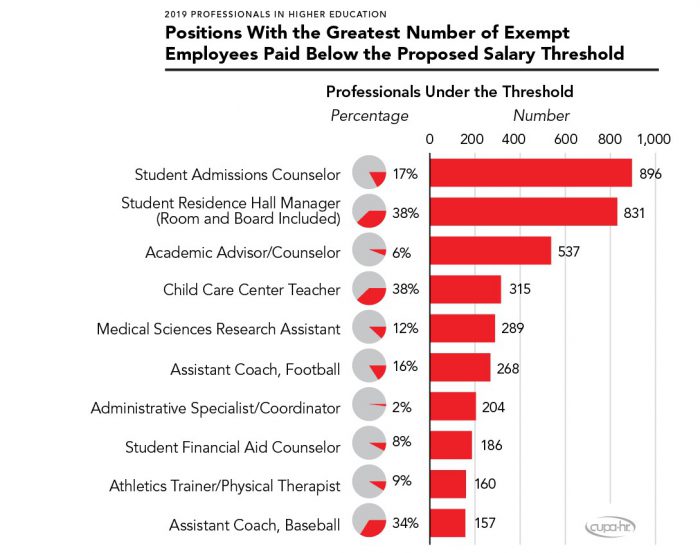Which Higher Ed Workers Are Most Likely to Be Impacted by DOL’s Proposed Overtime Rule?
The Department of Labor (DOL) in March released details of its proposed changes to the Fair Labor Standards Act (FLSA)’s overtime pay requirements governing exemptions for executive, administrative and professional (or “white-collar”) employees.
Findings from CUPA-HR’s 2019 Professionals in Higher Education Survey shed some light on which higher ed-specific professional-level positions are most likely to be impacted if the proposed salary threshold of $35,308 is implemented.
The survey found that the areas with a relatively high percentage of exempt employees below the proposed threshold include athletic affairs (12 percent) and student affairs (7 percent) (these two areas are also among the top three divisions on campus with highest percentage of professional workers). Specific positions currently below the threshold include student admissions counselors, student residence hall managers, childcare center teachers and assistant baseball coaches.

Of all higher education exempt professionals, 96 percent are currently paid at or above the proposed exemption threshold, meaning that only 4 percent of exempt professionals would need to be re-evaluated for possible exempt-status changes or salary increases if the proposed rule were to take effect.
Other findings from the 2019 CUPA-HR Professionals in Higher Education Annual Report include:
- The median salary increase for higher ed professionals over the past year was 2.17 percent, which is the same as last year and slightly below the rate of inflation. The median salary increase was highest at doctoral institutions (2.6 percent). Median increases were below 2 percent for all other types of institutions.
- Professionals in the area of health science and environmental sustainability make the highest salaries (median of $94,000). Within that area, staff physicians are the highest-paid professionals (median of $169,000).
- The fastest growing professional positions are head of IT information management (+63 percent) and senior planned giving officer (+53 percent).
- Nearly two-thirds (60 percent) of professionals are women, and nearly one-quarter (23 percent) are racial/ethnic minorities. Women are best represented in the area of health science and environmental sustainability and least represented in information technology. Racial/ethnic minorities are best represented in the area of research and least represented in external affairs.
- Women are paid less than men in every professional area. The greatest pay gap is in the area of health science and environmental sustainability, where women are paid only $0.88 on the dollar paid to their male counterparts. Professionals of color have large pay gaps in facilities and information technology positions. In contrast, Asian professionals are paid more than other racial/ethnic groups, including White professionals, in nearly every area, most notably in health science and environmental sustainability.
A total of 1,131 higher education institutions provided incumbent-level data for over 240,000 professionals in 387 positions for this year’s survey. The survey collects data on salaries and demographics for each individual incumbent, allowing for more in-depth analysis and comprehensive benchmarking. Data collected include salary, sex, race/ethnicity, and years in position. In addition, this is the third year the survey has collected exempt/non-exempt status for each professional incumbent, allowing institutions to benchmark exempt status prevalence and salaries for each professional position.
For a list of participating institutions, an overview of the results, information on data collected and options for purchasing the survey report and DataOnDemand, visit the Professionals in Higher Education web page.


